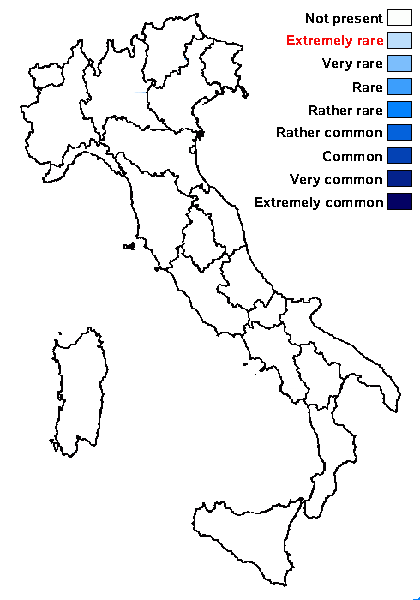Protothelenella xylina H. Mayrhofer & Poelt
Herzogia 7, 1-2: 58, 1985
Synonyms:
Distribution:
Description: Thallus crustose, often poorly evident, bright green, consisting of a few algal cells surrounded by hyphae, especially around the perithecia. Perithecia brown-black when dry, paler but always with a dark, finally broad ostiole when wet, globose to weakly pyriform, 0.15-0.25(-0.3) mm across, at least half-immersed in the thallus, covered with a thin colourless layer in lower part. Exciple brown in upper part, paler in lower part, of strongly anastomosing, conglutinate, to 1 μm thick hyphae with narrow lumina; paraphysoids persistent, thread-like, 0.7-1 μm thick, branched and anastomosing in lower part; periphysoids absent; hymenial gel I+ reddish or I+ blue at low concentrations, K/I+ blue. Asci 8-spored, narrowly cylindrical, short-stalked, thick-walled (2-3 μm), fissitunicate, the outer gelatinous wall layer I+ blue, with a very faintly I+ blue apical plug. Ascospores submuriform to muriform, with 3-5 tranverse septa and 1-2 longitudinal septa, hyaline, ellipsoid-oblong, (19-)24-32 x 10-14 μm, often attenuated at both ends. Photobiont chlorococcoid (Elliptochloris), the algal cells surrounded by a gelatinous sheath. Spot tests: K-, C-, KC-, P-, UV-. Chemistry: without lichen substances. Note: a species resembling P. sphinctrinoidella, but with an inconspicuous endoxylic thallus, and broader ascospores. growing on wood of Pinus cembra in the subalpine belt; rare in Central Europe, with a few records from the Alps (Switzerland, Austria); to be looked for in the Italian Alps.
Growth form: Crustose
Substrata: lignum
Photobiont: green algae other than Trentepohlia
Reproductive strategy: mainly sexual

Predictive model
Growth form: Crustose
Substrata: lignum
Photobiont: green algae other than Trentepohlia
Reproductive strategy: mainly sexual

Predictive model
 INDEX FUNGORUM
INDEX FUNGORUM
 GBIF
GBIF

